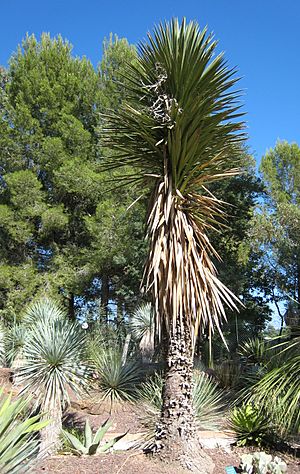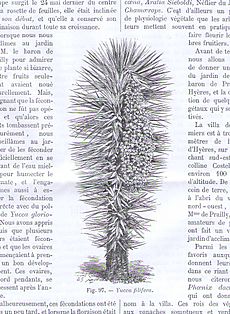Yucca filifera facts for kids
Quick facts for kids Yucca filifera |
|
|---|---|
 |
|
| Conservation status | |
| Scientific classification | |
| Genus: |
Yucca
|
| Species: |
filifera
|
| Synonyms | |
|
|
The Yucca filifera is a unique plant. It belongs to the Asparagaceae family, which includes many plants like asparagus. This yucca is originally from central Mexico. It is known for being a tall plant with many branches.
Contents
Discovering the Yucca
This special plant was first found in 1840. An explorer named Josiah Gregg discovered it in northeastern Mexico. This happened on May 19, 1847. Later, in 1876, the plant was brought to Europe. There, a scientist named J. Benjamin Chabaud officially described it for science.
What the Yucca Looks Like
The Yucca filifera is a very tall plant. It has many branches, which makes it look full. Its leaves are long and straight, shaped like swords. These leaves grow in a round shape, called a rosette, at the end of each stem.
When the plant blooms, it produces a long flower stalk. This stalk hangs down and has many white flowers. These flowers make the plant look very beautiful.
Yucca's Health Status
The Yucca filifera is not considered to be in danger. The IUCN (a group that checks on plants and animals) says it is safe. This is because it grows over a very large area. Also, the number of these plants seems to be staying steady.
People in Mexico use the plant for its strong fibers. Sometimes, its home might be slightly damaged. But overall, the plant is doing well.
How People Use the Yucca
The Y. filifera can grow well in dry places. It does not need a lot of water. Local people in Mexico use this plant in many ways. They call it palma china or izote.
They use its leaves to cover roofs. They also use the fibers from the plant to make handicrafts. This shows how useful the Yucca filifera is to the people who live near it.
There is a very big Yucca filifera plant at Stanford University. It stands in front of the Anderson Gallery. This huge plant was moved there in the 1880s. In the spring, it grows long groups of white flowers. Some of these flower groups can be over a meter long!
See also
 In Spanish: Yucca filifera para niños
In Spanish: Yucca filifera para niños



